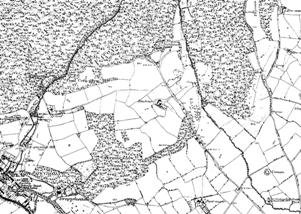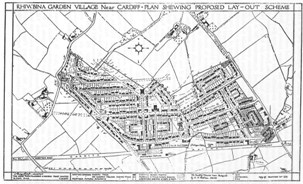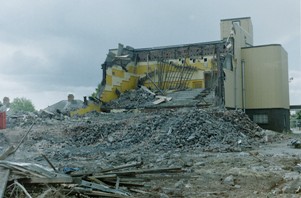THE HISTORY OF CARDIFF'S SUBURBS
RHIWBINA

Source: Unknown
CONTENTS
Tap or click to open / closeThe Twmpath
A small ancient earthwork, near the summit of Wenallt Hill, suggests that there was a settlement at Rhiwbina in the Iron Age.
Source: OS
Roman artifacts found on Rhiwbina Hill indicate that they too may have had a camp. From the Hill, settlers would have a wide view of the surrounding area.
The Twmpath is another site that has fascinated historians for many years. This mound, located below the Wenallt, was thought by some to be the burial place of a Welsh chief.
The site has been excavated but nothing has been found. The Twmpath was most likely a Norman motte, acting as a small fort and observation point.
Early Beginnings
Rhiwbina was built on land donated to the City by Lord Tredegar in the 19th century. Before World War One, Rhiwbina was sparsely populated, with a mansion (Greenhill) and just a few houses scattered along Beulah Road.
Near the Masons Arms and Tyn-y-Parc Farm were small cottages and factories. There were a number of large farms in the area such as the Rhiwbina, Tyn-y-Cae, Pant Mawr, Tyn-y-Coed.
Source: The Welsh Town Planning and Housing Trust Limited Cardiff
Many of these farms were named after the ancient woods that surrounded them and Wenallt woods are the last of a forest that once stretched as far as Snowden.
Deri Farm and Deri Grain Mill were both named after an Oak Tree that survived a direct lightning hit. All these buildings have long since vanished, but their names live on in the local landmarks and streets.
In 1884, a reservoir was built on the hill by the Cardiff Corporation to supplement the needs of a growing borough, and is now covered over.
Housing Developments
In 1911, Professor Stanley Jevons resigned his chair at University College Cardiff Economics Department, to found the Housing Reform Company.
This in turn led to the development of well-planned, beautiful garden suburbs around Cardiff and in 1912 the first registered housing society soon became the Rhiwbina Garden Village Society.
Each resident held shares and had a voice in the running of the society, rather like the Housing Associations of today.
The original Housing Reform Company was made defunct during World War One, but in 1919 the Welsh Town Planning and Housing Trust funded the building of nearly 200 new homes.
Expansion and Conservation
Source: David Thomas ⁄ © Matthew Witty
Shops, churches and a library were built to meet the needs of the growing village. A recreation club and Rhiwbina School were both built in the 1920s, and at that time the school was the largest elementary in Glamorgan.
Opposite the school is the Memorial Hall, which was opened by in 1957.
In 1937, the Monico Cinema opened with a showing of "The lives of A Bengal Lancer". The landmark building was sadly demolished in 2009, being replaced with flats.
In 1962 the residents of Rhiwbina celebrated the 50th anniversary of the garden city project, but by 1976 the Society was dissolved.
When Rhiwbina became part of Cardiff in 1974, much of the area and Wenallt woods were designated conservation areas, and growth of the suburb has been restricted by the boundary of the M4 to the north.
PAGE UPDATE HISTORY
01 April 2024 (Content and coding updates)
01 December 2014 (Coding updates)
July 2009 (Page Created)



